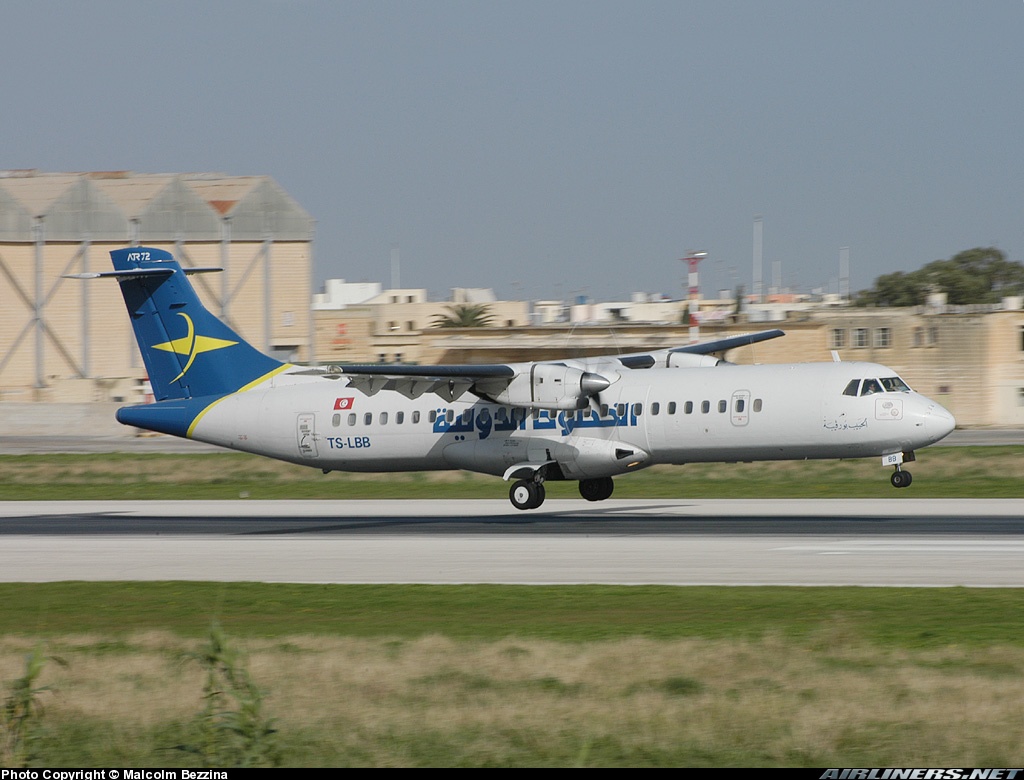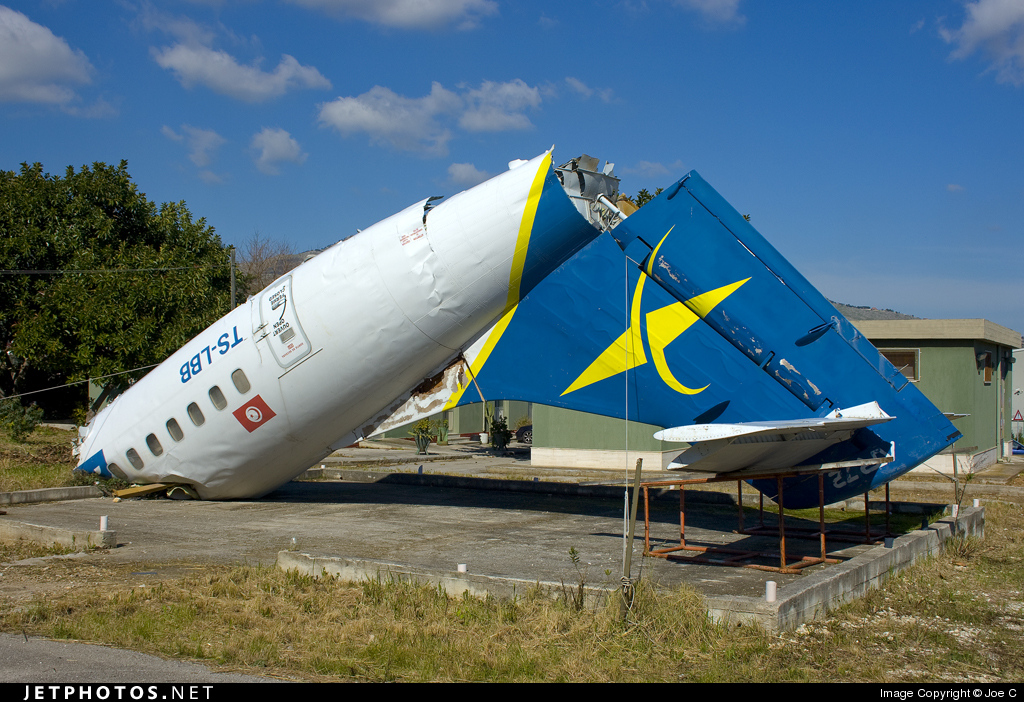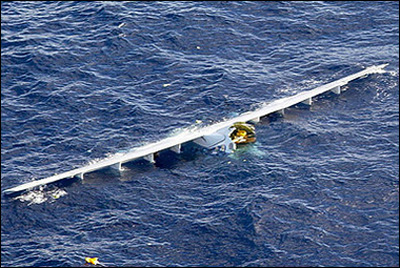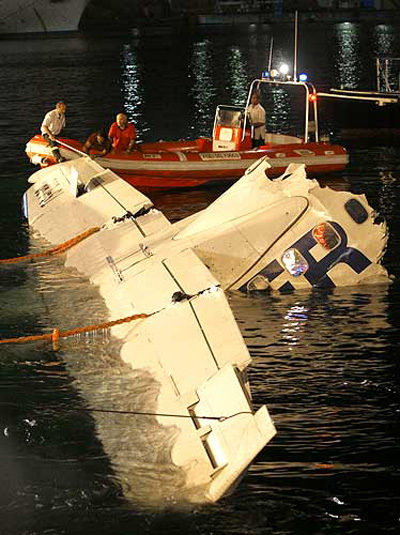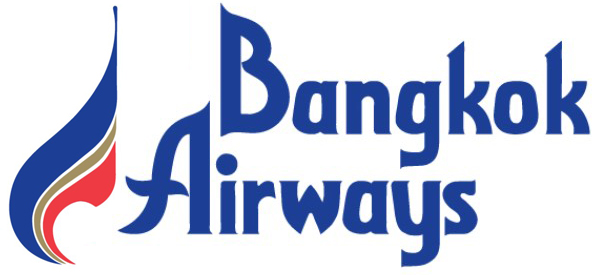Country
Crash of an ATR72-212 in Mumbai
Date & Time:
Nov 10, 2009 at 1640 LT
Registration:
VT-KAC
Survivors:
Yes
Schedule:
Bhavnagar - Mumbai
MSN:
729
YOM:
2006
Flight number:
IT4124
Crew on board:
4
Crew fatalities:
Pax on board:
38
Pax fatalities:
Other fatalities:
Total fatalities:
0
Captain / Total hours on type:
2241.00
Copilot / Total hours on type:
613
Aircraft flight hours:
9318
Circumstances:
As per the NOTAM, Runway 14/32 was under permanent maintenance on every Tuesdays since 10/11/2009 runway 27 was available only after runway intersection as runway 27A. To carry out operations on this reduced runway 27 a NOTAM ‘G’ No. G 0128/08 was issued by AAI on the same day of accident i.e. 10-11-2009 and designated as runway 27A for visual approach only. As per the NOTAM Landing Distance Available (LDA)/take off Distance available (TODA) was 1703 m. The weather conditions prevailing at the time of accident was winds 070/07 knots visibility 2800 m with feeble rain. Prior to Kingfisher aircraft, Air India aircraft IC-164, Airbus 319 had landed and reported to ATC that it had aquaplaned and broken two runway edge lights. The ATC acknowledged it and sent runway inspection vehicle to inspect the runway. The ATC person was not familiar with the terminology of ‘aquaplaning’ and not realizing the seriousness of it, cleared kingfisher aircraft for landing. At the time of accident there were water patches on the runway. ATC also did not transmit to the Kingfisher aircraft the information regarding aquaplaning reported by the previous aircraft. The DFDR readout revealed that kingfisher aircraft was not on profile as per localizer procedure laid down in NOTAM ‘G’ and was high and fast. The aircraft landed late on the runway and the runway length available was around 1000 m from the touchdown point. In the prevailing weather conditions this runway length was just sufficient to stop the aircraft on the runway. During landing the kingfisher aircraft aquaplaned and did not decelerate even though reversers and full manual braking was applied by both the cockpit crew. The aircraft started skidding toward the left of center line. On nearing the runway end, the pilot initiated a 45 ° right turn, after crossing ‘N 10’ Taxi track, the aircraft rolled into unpaved wet area. Aircraft rolled over drainage pipes & finally came to a stop near open drain. There was no fire. All the passenger safely deplaned after the accident.
Probable cause:
The accident occurred due to an unstabilized approach and decision of crew not to carry out a ‘Go-around’.
Contributory Factors:
i) Water patches on the runway 27
ii) Inability of the ATCO to communicate the aircraft about aquaplaning of the previous aircraft
iii) Lack of input from the copilot.
Contributory Factors:
i) Water patches on the runway 27
ii) Inability of the ATCO to communicate the aircraft about aquaplaning of the previous aircraft
iii) Lack of input from the copilot.
Final Report:
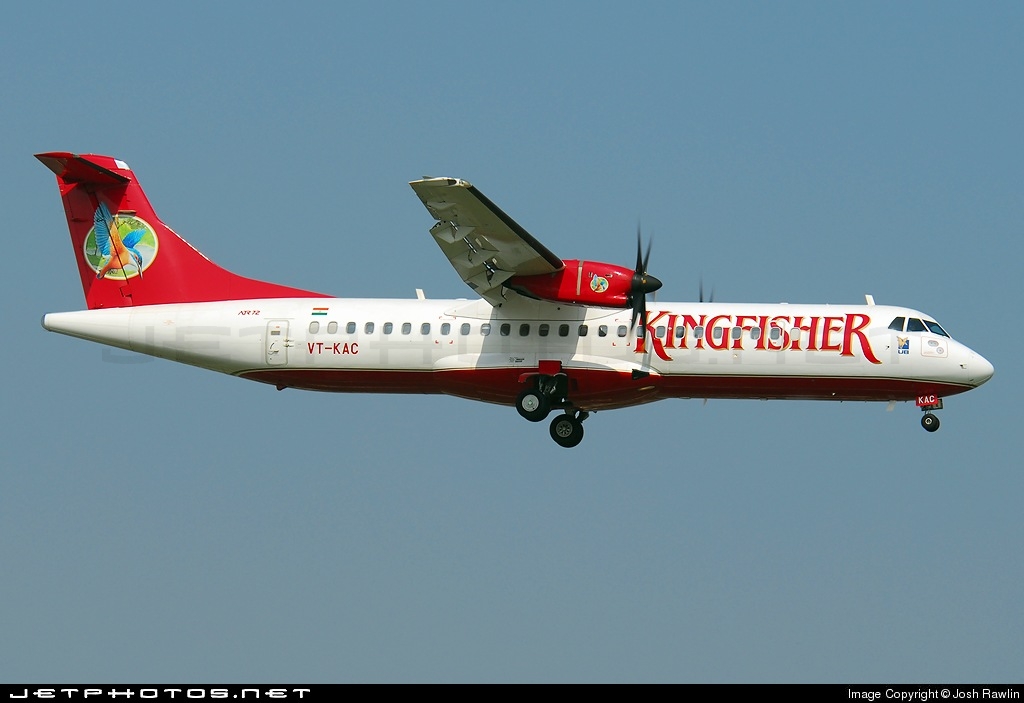
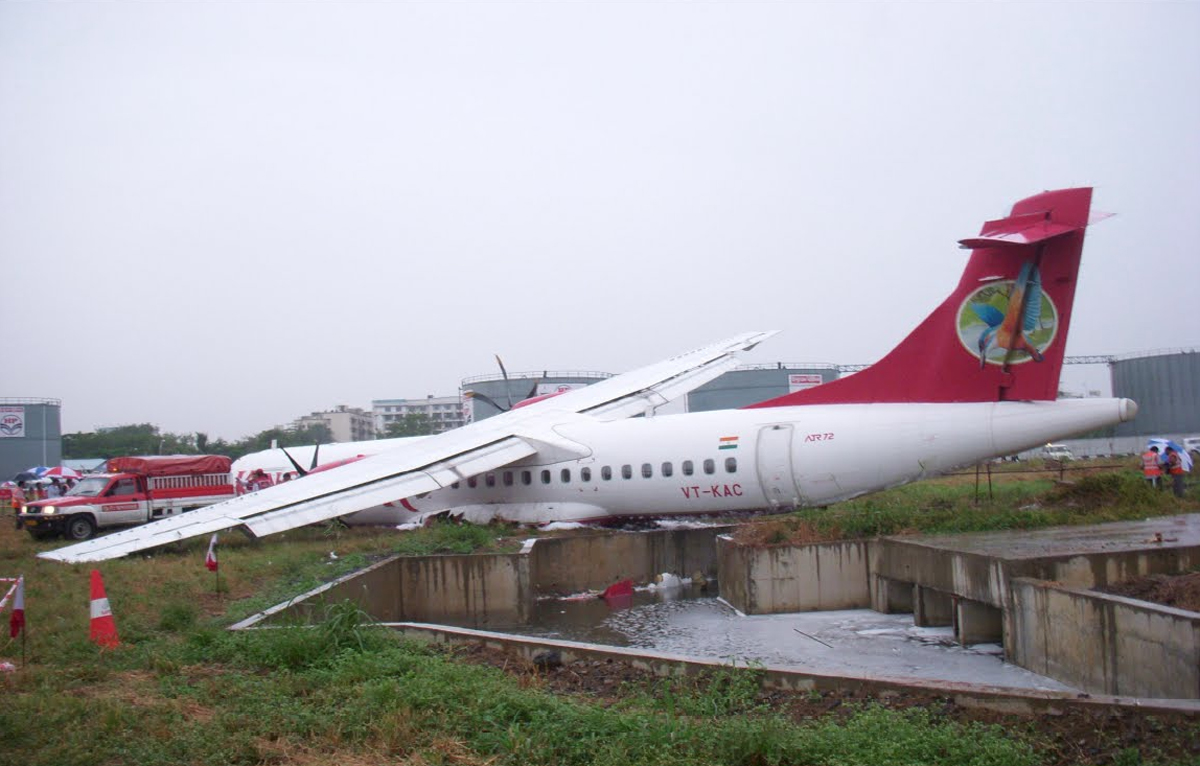
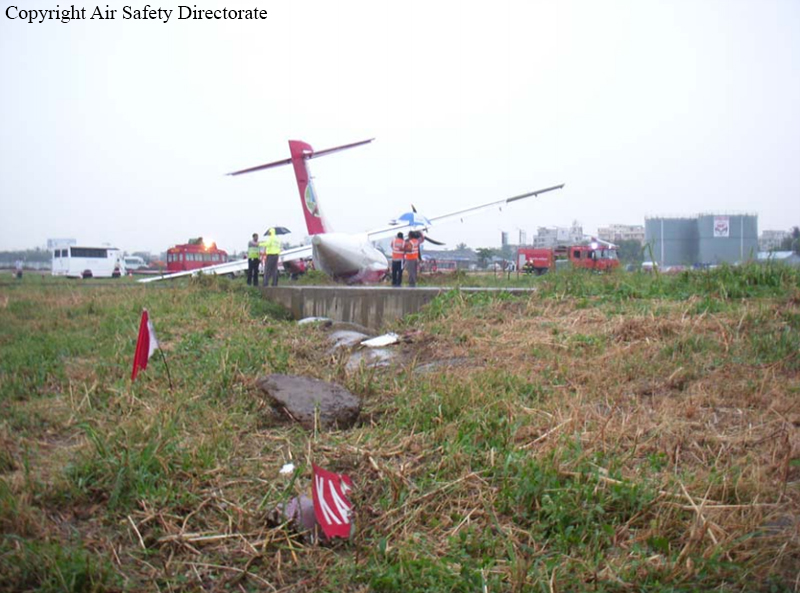
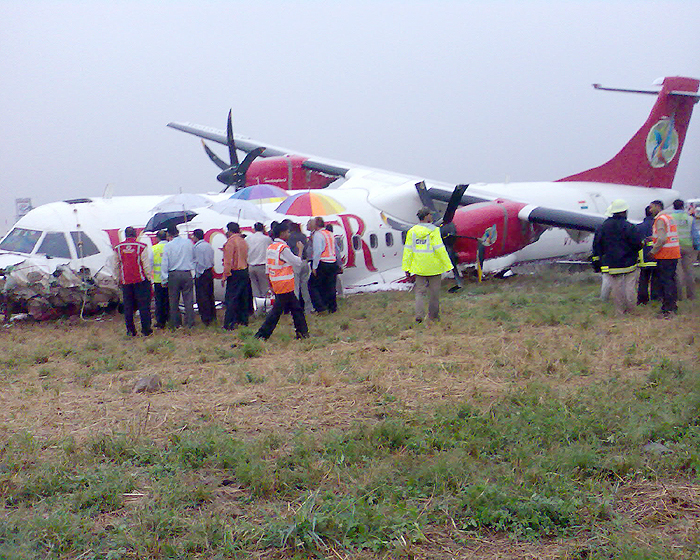
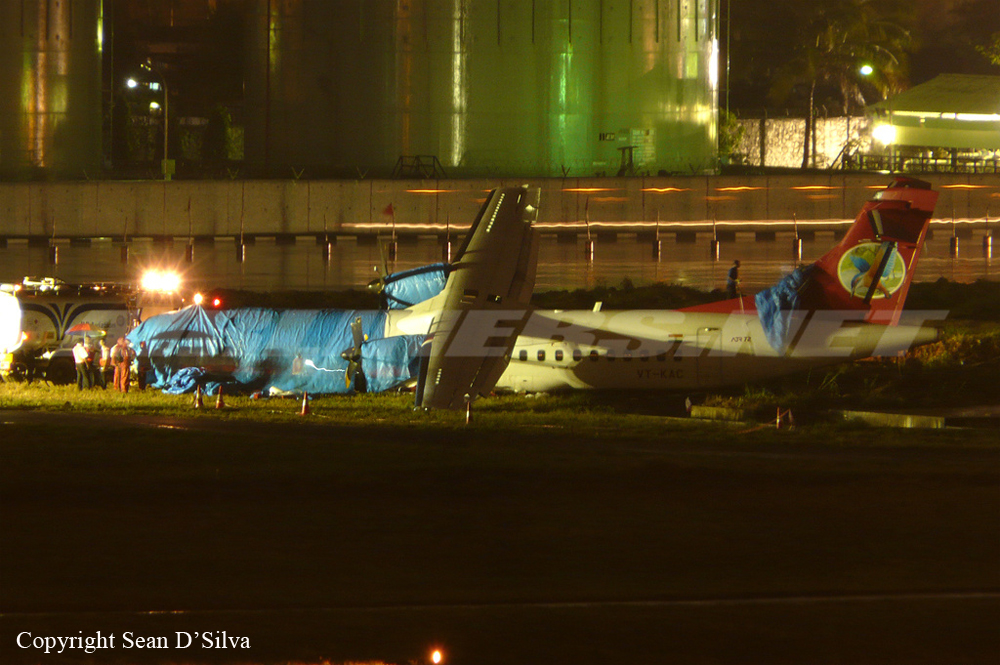
Crash of an ATR72-212A in Koh Samui: 1 killed
Date & Time:
Aug 4, 2009 at 1430 LT
Registration:
HS-PGL
Survivors:
Yes
Schedule:
Krabi – Koh Samui
MSN:
670
YOM:
2001
Crew on board:
4
Crew fatalities:
Pax on board:
68
Pax fatalities:
Other fatalities:
Total fatalities:
1
Circumstances:
Following an uneventful flight from Krabi, the crew started the approach to Koh Samui Airport. Conditions at destination were marginal with stormy weather, winds and turbulences. Upon landing on runway 35, the aircraft bounced then landed a second time. It deviated from the centerline to the left, veered off runway, rolled through a grassy area and eventually collided with the concrete structure of the airport tower. The captain was killed and the copilot was seriously injured as the cockpit area was destroyed upon impact. 26 other people were injured.
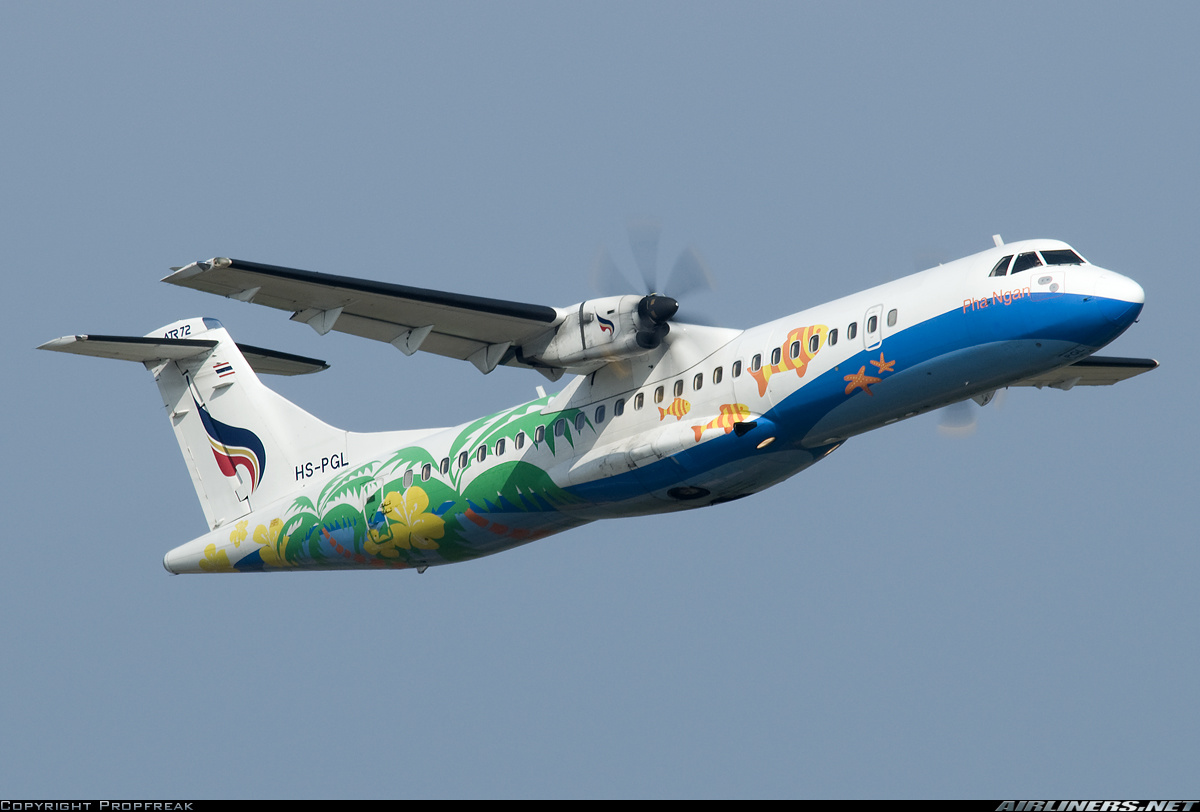
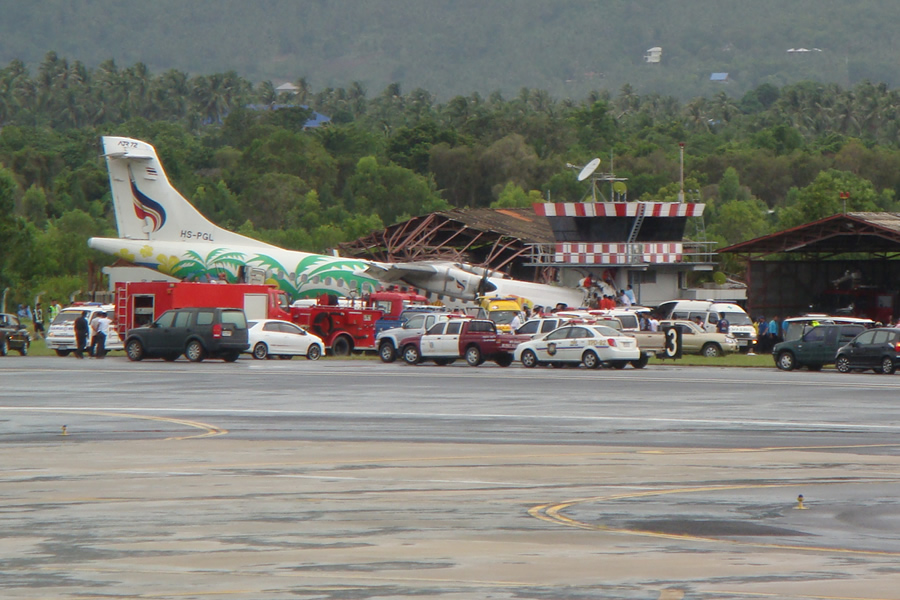
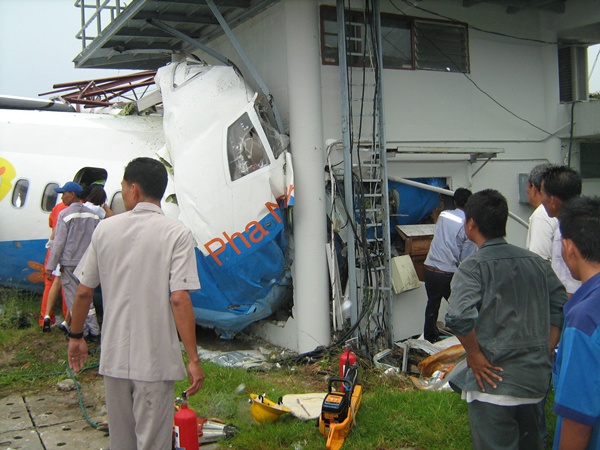
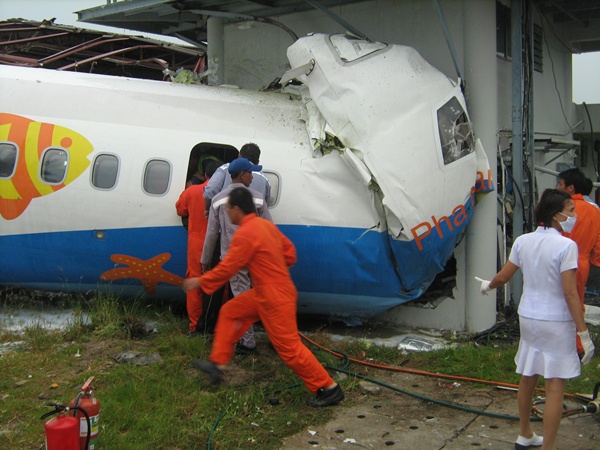

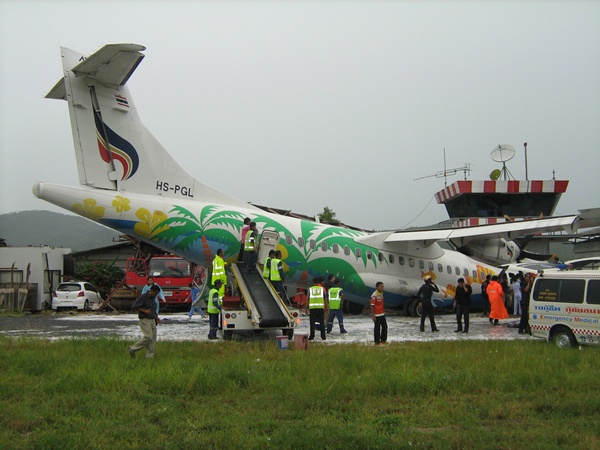


Crash of an ATR72-212 in Putao
Date & Time:
Feb 19, 2008
Registration:
XY-AIE
Survivors:
Yes
Schedule:
Putao - Myitkyina
MSN:
458
YOM:
1995
Flight number:
JAB252
Crew on board:
4
Crew fatalities:
Pax on board:
53
Pax fatalities:
Other fatalities:
Total fatalities:
0
Circumstances:
During the takeoff roll, the captain noticed an asymmetrical engine thrust and decided to reject takeoff. Unable to stop within the remaining distance, the aircraft overran, rolled for about 30 metres and collided with an embankment, coming to rest broken in two. All 57 occupants evacuated safely.
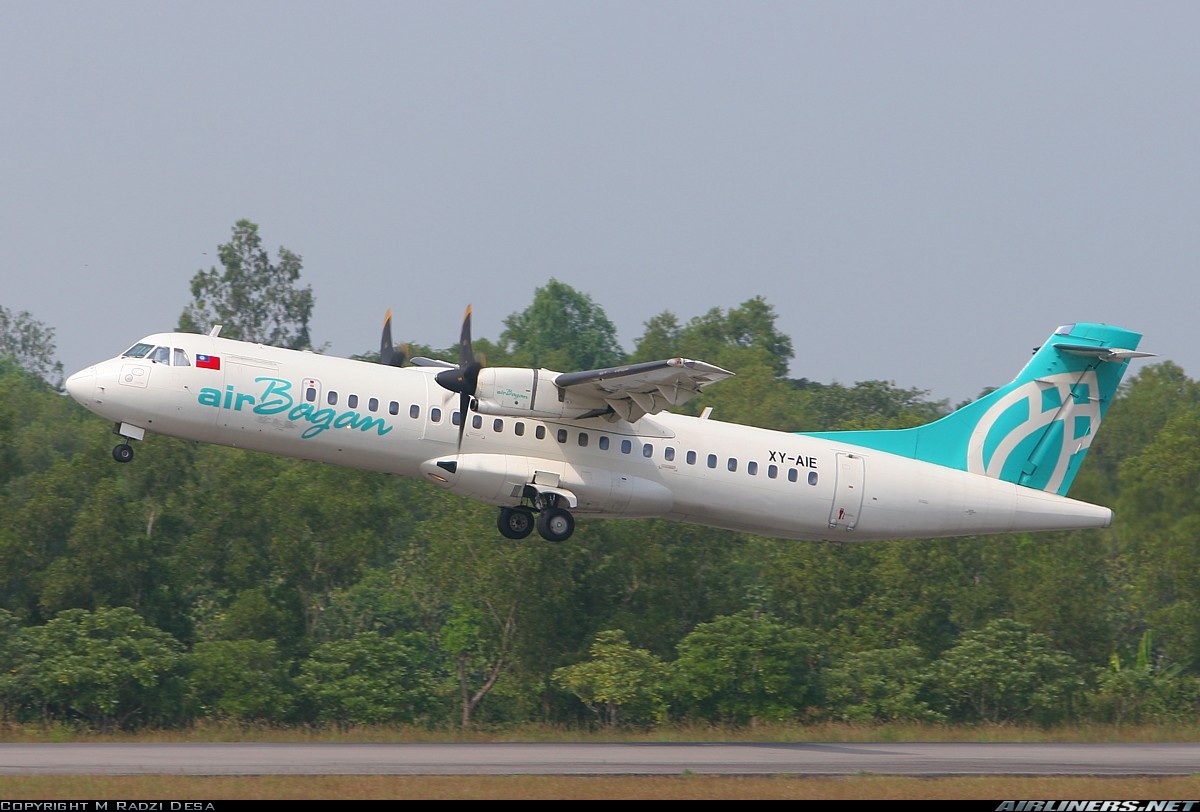
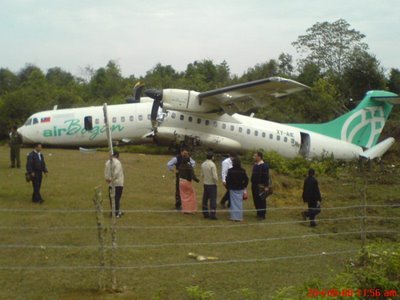
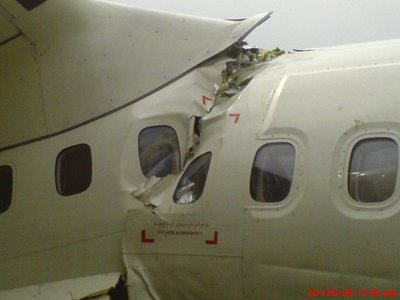
Crash of an ATR72-212A in Indore
Date & Time:
Jul 1, 2007 at 1946 LT
Registration:
VT-JCE
Survivors:
Yes
Schedule:
Bhopal - Indore
MSN:
640
YOM:
2000
Flight number:
JAI3307
Crew on board:
4
Crew fatalities:
Pax on board:
49
Pax fatalities:
Other fatalities:
Total fatalities:
0
Circumstances:
The flight up-till approach to land at Indore was normal. On coming to the runway the aircraft touched down moderately hard and bounced high. The pilots were perhaps determined to salvage the abnormal situation and added power to the engines with intention to cushion the sink-rate and settle the runway. On the contrary, the aircraft came hard on the runway and bounced once again. This got followed with a series of bounces in succession. While bouncing the aircraft migrated from the runway and finally came to full halt on right side close to the airport boundary wall. There was no fire in the accident. All 53 occupants evacuated safely.
Probable cause:
The pilot-in-command in absence of bounce recovery guidance adopted self-perceived technique and kept on adding engine power along with aircraft pitch manipulations to salvage the aircraft from the bounce on landing, and gravely damaged the aircraft structure.
Final Report:
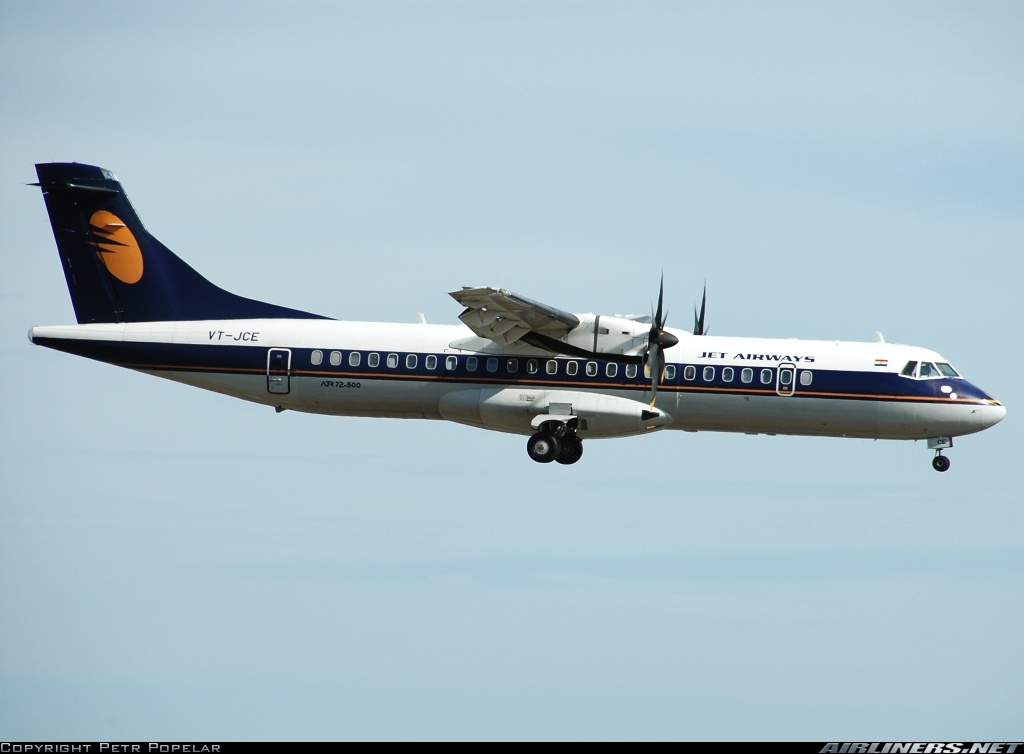
Crash of an ATR72-212A in Bangalore
Date & Time:
Mar 11, 2006 at 1017 LT
Registration:
VT-DKC
Survivors:
Yes
Schedule:
Coimbatore – Bangalore
MSN:
721
YOM:
2005
Flight number:
DN108
Crew on board:
4
Crew fatalities:
Pax on board:
40
Pax fatalities:
Other fatalities:
Total fatalities:
0
Circumstances:
The twin engine aircraft landed hard on runway 27 at Bangalore-Hindustan Airport. After touchdown, it veered off runway and came to rest. All 44 occupants escaped uninjured while the aircraft was damaged beyond repair. Brand new, it was delivered four months ago.


Crash of an ATR72-202 off Palermo: 16 killed
Date & Time:
Aug 6, 2005 at 1539 LT
Registration:
TS-LBB
Survivors:
Yes
Schedule:
Bari – Djerba
MSN:
258
YOM:
1992
Flight number:
TUI1153
Crew on board:
4
Crew fatalities:
Pax on board:
35
Pax fatalities:
Other fatalities:
Total fatalities:
16
Captain / Total hours on type:
5582.00
Copilot / Total hours on type:
2130
Aircraft flight hours:
29893
Aircraft flight cycles:
35259
Circumstances:
The aircraft departed Bari at 1432LT on flight TUI1153 to Djerba with 39 people on board, 4 crew members, 35 passengers among which one airline engineer. While cruising, approximately 50 minutes after takeoff, at flight level 230, the right engine shut down and after approximately 100 seconds, also the left engine shut down. The flight crew decided to divert to the airport at Palermo, Punta Raisi, to make a precautionary landing. The crew referred to having tried to restart both engines, but without success. After gliding approximately 16 minutes, the aircraft ditched approximately 23 nautical miles northeast from Palermo's airport, Punta Raisi, within Italian territorial waters. On impact with the surface of the sea, the aircraft broke into three pieces; 14 passengers, the airliner engineer and a member of the crew (senior flight attendant) reported fatal injuries. The other occupants suffered serious to minor injuries.
Probable cause:
The accident under examination, as most aviation accidents, has been determined by a series of events linked one another, which caused the final ditching. The ditching was primarily due to the both engines flame out because of fuel exhaustion. The incorrect replacement of the fuel quantity indicator (FQI) was one of the contributing factors which led irremediably to the accident. The accident’s cause is therefore traceable firstly to the incorrect procedure used for replacing the FQI, by means of the operator’s maintenance personnel. This shall be considered the disruptive element, which caused the final ditching of the aircraft due to the lack of fuel that caused the shutdown of both engines. As said before the accident was determined by a series of events (contributing factors) linked one another. Hereafter are listed some considered of major importance.
- Errors committed by ground mechanics when searching for and correctly identifying the fuel indicator.
- Errors committed by the flight crew: non-respect of various operational procedures.
- Inadequate checks by the competent office of the operator that flight crew were respecting operational procedures.
- Inaccuracy of the information entered in the aircraft management and spares information system and the absence of an effective control of the system itself.
- Inadequate training for aircraft management and spares information system use and absence of a responsible person appointed for managing the system itself.
- Maintenance and organization standards of the operator unsatisfactory for an adequate aircraft management.
- Lack of an adequate quality assurance system;
- Inadequate surveillance of the operator by the competent Tunisian authority.
- Installation characteristics of fuel quantity indicators (FQI) for ATR 42 and ATR 72 which made it possible to install an ATR 42 type FQI in an ATR 72, and vice versa.
The analysis of various factors that contributed to the event has been carried out according to the so called Reason’s "Organizational accident" model. Active failures, which had triggered the accident, are those committed both by ground mechanics/technicians the day before the event while searching for and replacing the fuel quantity indicator, and by the crew who did not verify and fully and accurately complete the aircraft’s documentation, through which it would have been possible to perceive an anomalous situation regarding the quantity of fuel onboard. Latent failures, however, remained concealed, latent in the operator’s organizational system until, some active errors (by mechanics and pilots) were made, overcoming the system’s defence barriers, causing the accident. Analysing latent and active failures (errors) traceable to various parties, involved in the event in several respects, it clearly emerges that they were operating in a potentially deceptive organizational system. When latent failures remain within a system without being identified and eliminated, the possibility of mutual interaction increases, making the system susceptible for active failures, or not allowing the system to prevent them, in case of errors. Active failures were inserted in a context characterised by organizational and maintenance deficiencies. The error that led to the accident was committed by mechanics who searched for and replaced the FQI, but this error occurred in an organizational setting in which, if everybody were operating correctly, probably the accident would not have occurred. Inaccuracy of information entered in the aircraft management and spares information system, particularly regarding the interchangeability of items and the absence of an effective control of the system itself, has been considered in fact one of the latent failures that contributed to the event. The maintenance and organization standards of the operator, at the time of event, were not considered satisfactory for an adequate management of the aircraft. The flight crew and maintenance mechanics/technicians involved in the event, when they made incorrect choices and took actions not complying with standard procedures, did not receive sufficiently effective aid from the system in order to avoid the error.
- Errors committed by ground mechanics when searching for and correctly identifying the fuel indicator.
- Errors committed by the flight crew: non-respect of various operational procedures.
- Inadequate checks by the competent office of the operator that flight crew were respecting operational procedures.
- Inaccuracy of the information entered in the aircraft management and spares information system and the absence of an effective control of the system itself.
- Inadequate training for aircraft management and spares information system use and absence of a responsible person appointed for managing the system itself.
- Maintenance and organization standards of the operator unsatisfactory for an adequate aircraft management.
- Lack of an adequate quality assurance system;
- Inadequate surveillance of the operator by the competent Tunisian authority.
- Installation characteristics of fuel quantity indicators (FQI) for ATR 42 and ATR 72 which made it possible to install an ATR 42 type FQI in an ATR 72, and vice versa.
The analysis of various factors that contributed to the event has been carried out according to the so called Reason’s "Organizational accident" model. Active failures, which had triggered the accident, are those committed both by ground mechanics/technicians the day before the event while searching for and replacing the fuel quantity indicator, and by the crew who did not verify and fully and accurately complete the aircraft’s documentation, through which it would have been possible to perceive an anomalous situation regarding the quantity of fuel onboard. Latent failures, however, remained concealed, latent in the operator’s organizational system until, some active errors (by mechanics and pilots) were made, overcoming the system’s defence barriers, causing the accident. Analysing latent and active failures (errors) traceable to various parties, involved in the event in several respects, it clearly emerges that they were operating in a potentially deceptive organizational system. When latent failures remain within a system without being identified and eliminated, the possibility of mutual interaction increases, making the system susceptible for active failures, or not allowing the system to prevent them, in case of errors. Active failures were inserted in a context characterised by organizational and maintenance deficiencies. The error that led to the accident was committed by mechanics who searched for and replaced the FQI, but this error occurred in an organizational setting in which, if everybody were operating correctly, probably the accident would not have occurred. Inaccuracy of information entered in the aircraft management and spares information system, particularly regarding the interchangeability of items and the absence of an effective control of the system itself, has been considered in fact one of the latent failures that contributed to the event. The maintenance and organization standards of the operator, at the time of event, were not considered satisfactory for an adequate management of the aircraft. The flight crew and maintenance mechanics/technicians involved in the event, when they made incorrect choices and took actions not complying with standard procedures, did not receive sufficiently effective aid from the system in order to avoid the error.
Final Report:
